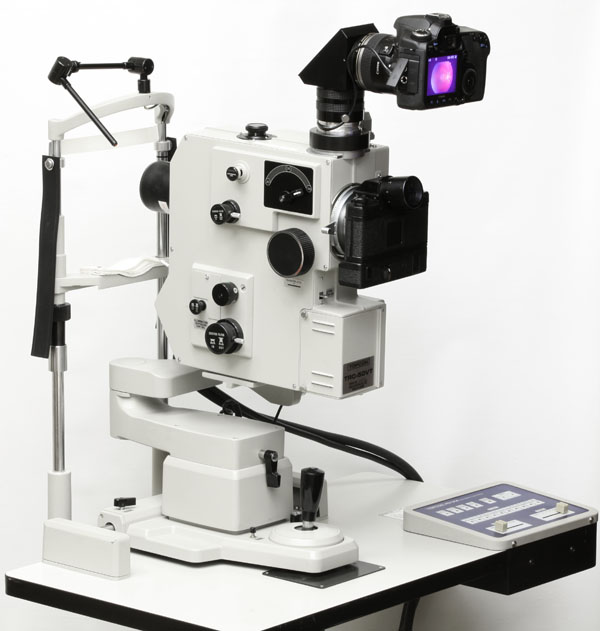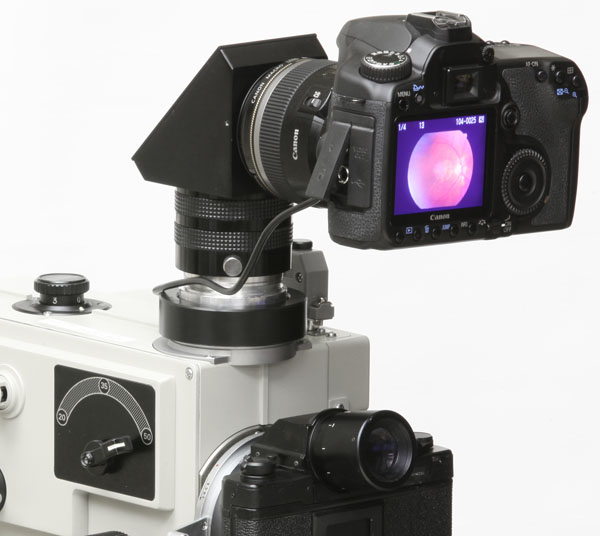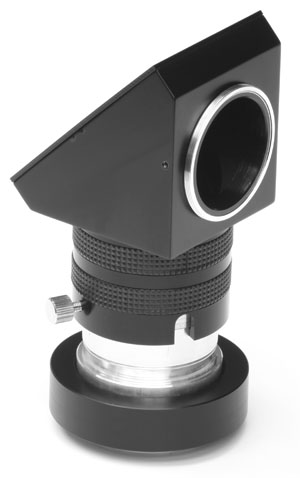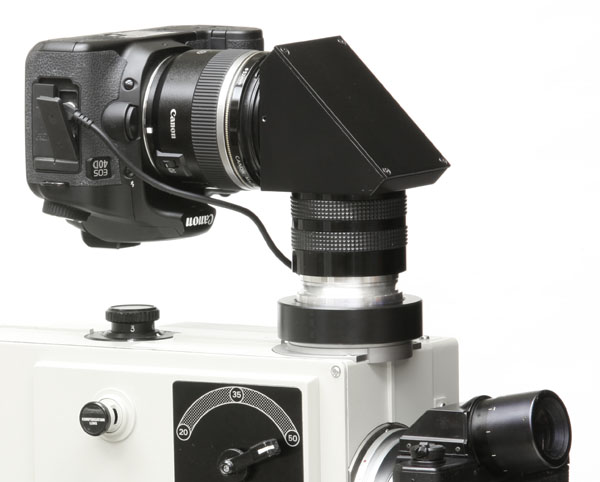
Figure 1. Topcon TRC-50VT with upper-port diagonal adapter for Canon digital camera (overall view).
This shows the normal rearward orientation of the adapter, facing the operator.
Richard J Kinch
http://www.truetex.com
February, 2024
This document describes how to install and operate the digital camera upgrade kit for the upper port of the Topcon TRC-50VT retinal camera.
Identify the upgrade kit contents:
Other components you must obtain separately:
The adapter kit works by design with ordinary, standard Canon retail camera bodies and lenses, and with the constantly improving standard computer software supporting digital photography. No special version or modifications of hardware or software are required. New Canon camera models in the future should also be compatible, as should advances in Canon and third-party computer software support. You may process the standard RAW or JPEG images using industry standard software such as Adobe Photoshop or Corel PhotoPaint.
Optional components you may wish to obtain separately:
Familiarize yourself with the digital camera and lens: If the digital camera is new to you, study at least the following features which will be used for retinal photography: On/off switch, mode switch "M" setting for manual operation, setting manual exposure time, attaching and removing lenses, remote shutter release connector, hot shoe, viewing photos on the camera, transferring photos to a computer.
Also read the instruction manual for the Canon 60mm lens to learn about the following features of the lens: filter mounting thread, focusing ring, focus mode switch, and distance scale. You must understand these features to apply the manual focus calibration procedure below, which is mandatory for proper operation of the adapter.
Install the joystick interpolation connector-cable, and the flash jumper plug: This installation step is covered in a separate instruction document, a printed copy of which is included with the adapter.
Choose an adapter orientation: The adapter orients on the upper port in one of two ways: (1) the normal rearward direction facing the operator, or (2) above the top of the instrument, with the camera inverted and facing away from the operator. The adapter is delivered to you in the normal rearward orientation, which is what most practitioners choose. See Figure 1 (normal rearward) versus Figure 5 (forward) below. You should choose one of these orientations to initially install the adapter. The forward orientation places the digital camera upright and directly over the top of the Topcon upper unit. This is the most compact orientation and does not place the camera close to the operator's head while viewfinding, but less convenient because the camera controls face away from the operator, making it awkward to review photos on the camera display, and practically requiring an external HDTV display or tethered PC.
Attach the Canon lens to the adapter: Observe that the diagonal adapter provides a Topcon upper-port lockring fitting, and a 52mm threaded lens fitting. Take care especially with the Topcon fitting, since the aperture is thin and fragile.
Observe that three setscrews attach and lock the threaded fitting to the diagonal. See Figure 2 below. This fitting rotates when the setscrews are loosened, and adjustment of this rotation is a part of assembling the lens to the adapter. You may loosen and tighten these setscrews with the provided 1.3mm hex key. By carefully adjusting the rotation and locking the adjustment with the setscrews, you perform several critical adjustments: the upright versus inverted orientation of the camera to the adapter, the alignment of the adapter squarely to the instrument, and the alignment of the camera squarely to the image. See Figure 3 versus Figure 7 below. The side faces and end face of the diagonal each show one setscrew.
Normally you need to adjust only the threaded lens fitting when installing the Canon lens, and not the locking fitting. Adjust the locking fitting only if you are switching the orientation of the adapter from rearward to forward or vice versa, using the procedure in the following inset paragraphs:
To adjust the lockring fitting: Loosen the setscrew with the 2mm hex key, and rotate the fitting. Tighten the setscrew to lock the fitting. The fitting will also slide in and out when you loosen the setscrew, but normally you should leave it inserted fully in. You may raise the adapter slightly by moving the fitting insertion out.
To install the Canon 60mm lens on the threaded fitting, first screw the lens hand-tight onto the threaded fitting until the lens seats. Do not tighten too firmly, but just enough to seat the lens on the threaded fitting. Take care with these threads as they are very fine and easily damaged if misthreaded. Loosen the side setscrews which lock the fitting to the diagonal, using the 1.3mm hex key. Lightly tighten the side setscrews for the lens fitting. Attach the Canon camera body to the lens. Rotate the lens fitting in the diagonal to the proper angle for the rearward or forward orientation you have chosen. See Figure 1 (rearward orientation) versus Figure 5 (forward orientation) below. Finally, tighten the setscrews firmly.
Calibrate the focus of the Canon camera to the Topcon instrument: Focus calibration is a quick and easy, one-time procedure, but it is absolutely critical to the proper performance of the adapter. You must set the digital camera lens to a fixed, manual focus on the adapter's field stop, which permits you later to focus the retinal image in the normal way. If the focus calibration is off, then all digital photos will be out of focus even though the instrument display indicates a correct focus on the patient eye. Proceed as follows:
Alternative focus calibration methods: You may also calibrate the adapter focus by focusing an image in the instrument and then focusing the digital camera to the same image, as follows. Set up a distant focusing target in the center of the instrument view, such as a small, bright light across the room or down a hallway. A distant, luminous, pinpoint test target will greatly simplify the focusing image and improve the accuracy of the calibration. A lighted ophthalmoscope, transillumination lamp, or penlight are excellent for this purpose, as they provide an "artificial star" test target. Focus on the test target with the Topcon viewfinder (use the "+" diopter compensation lens setting on the instrument to focus on the near-infinity object). Take care to compensate for any refraction error in your observing eye by rotating diopter correction in the viewfinder eyepiece, so that the viewfinder crosshairs appear in sharp focus. Once the test target is focused using the Topcon viewfinder, flip the upper-port mirror in the Topcon TRC-50VT upper unit by switching the Topcon unit on and selecting the "TV" mode on the console. This should redirect the image to the upper port, so you can now see the same image in the digital camera viewfinder, being careful not to alter the Topcon focus knob or carriage position. While watching the Canon viewfinder image, turn the focusing ring on the Canon lens to focus the image in the Canon viewfinder. Lock this precise focus with a sticker on the lens.If your Canon model provides a live view feature (Canon models XSi, T1i, T2i, 40D, 50D, 7D, etc), you can focus even more accurately than with the viewfinder, by viewing the 10X live view magnification of the test target instead of looking into the digital camera viewfinder.
If you don't have the live view feature, you can still take test photos on the digital camera and enlarge them on the digital camera display, to set the focus accurately by trial and error. It is easiest to do this by digitally photographing and reviewing the "artificial star" described above.
Connect the joystick interpolation cable to the digital camera: Connect the joystick interpolation cable to the digital camera's remote control socket on the left side of the camera body. You should have already installed the cable and the flash jumper plug as directed in the separate printed instructions reference above. Likewise you should have already covered the pogo pins on the rear port with a paper sticker from those same instructions.
Attach the digital camera with adapter to the Topcon instrument: Attach the adapter to the upper port of the Topcon instrument in the usual way. That is, mate the adapter to the upper-port receptacle, insert fully, engage the threaded lockring, and turn the lockring snug. Tighten the lockring only hand-tight.
Configure the Canon camera for retinal photography:
Configure the Topcon instrument for digital photography:
Adjust the instrument for a fixed test subject: Tape a business card or other flat, high-contrast, detailed subject to the patient headrest to serve as a fixed test target. A long strip of clear packing tape stuck across the headrest poles at the canthus marks will serve well. Stick the tape to the operator's side of the poles, and stick the card slightly to one side, roughly offset to where a patient eye would be position. Frame and focus a view of this target using the Topcon viewfinder in the normal fashion, perhaps pulling away from the subject and using the "+" diopter compensation lens, as for anterior segment views.
Take test subject exposures: Focus and align on the test subject using the viewfinder in the usual way. Press the joystick button to trigger an exposure. At the moment of exposure, listen for the Canon camera mirror flip and shutter mechanisms operating, along with the Topcon mirror mechanism flipping. Observe the light of the retinal camera flash on the subject. Immediately after the exposure, the Canon camera should momentarily display a view of the image on the camera display.
Reviewing test subject exposures: If you are using a tethered PC to capture photos, refer to the tethering software user manual for image review. If you are using the stand-alone camera to shoot onto the camera's memory card (with no tethered PC), use the Canon menu buttons to manually review exposures on the camera display. You may lengthen the automatic review time with the "Review time" menu setting on the digital camera. Zoom in when reviewing images to verify that the captured image appears sharply in focus when the video viewfinder also appeared in focus. Note that the full resolution of the digital camera is much finer than the instrument resolution, so the highest-resolution images will not appear in focus when zoomed in completely.
Taking live subject exposures: It is most convenient to obtain a cooperative colleague or patient for your first live retinal digital image tests. Collimate and focus on the retina in the usual way with the video display, using the joystick button to take exposures. Check the images for exposure brightness and adjust the Topcon flash energy to compensate.
Analyzing exposures for optimal exposure: Viewing the image exposure histogram in the digital camera is the only sure way to evaluate a proper exposure. The histogram provides a quantitative analysis of your retinal images for proper exposure level and degree of contrast. The goal is to have a histogram spread roughly in the middle third of the dynamic range. For color retinal photography, observe the green histogram rather than the white, since for a retinal image most of the diagnostic information is represented in the green portion of the color spectrum. The position of the hump in the histogram indicates the exposure level, which should be around the middle of the range, and the width of the hump indicates the contrast. If the histograms indicate an exposure off to one end or the other of the camera's dynamic range, you may adjust the sensitivity of the camera up or down with the ISO speed, aperture setting, or both. You may also adjust the Topcon flash energy applied.
Correcting exposures and improving contrast with digital post-processing: Simple post-processing of your digital images on a computer will correct many mis-exposures and improve correct exposures. Retinal images are by nature limited in contrast, and by digitally stretching the contrast, the visual impression of the photographic is much improved. Filtering enhancements such as red-free images are available via digital post-processing, even though the original instrument lacks the physical filters.
Establishing your practice routine: After completing the above, you will have a powerful digital facility for retinal photography. You must now handle digital data where you used to handle 35mm film slides or Polaroid prints. It most regards the digital methods are quicker, easier, and cheaper than film, but do require an initial investment in careful design and training. Your digital system is based on standard digital cameras, and so is compatible with ordinary software for capturing, post-processing, and cataloging digital photographs. Your upgraded digital retinal camera should, with occasional maintenance, provide decades of reliable service.
Relative exposure factors for color photography with film versus digital cameras: You should understand the relative exposure intensity of the digital camera versus the 35mm film formerly used. The digital sensor frame is smaller than the area of the original 35mm film frame by a factor of 1:2.8, and consequently the same flash energy yields 2.8 times more light intensity on the sensor. Because of this increased intensity, the slowest sensitivity setting on the digital camera (ISO 100) with the lowest flash energy setting on the TRC-50VT (18 watt-seconds) will tend to overexpose color photos. We therefore must apply a smaller aperture setting in the lens to stop some of the light. Setting a smaller manual aperture of f4.0 instead of the widest setting of f2.8 will compensate when shooting with a ISO 100 digital camera sensitivity setting.The retinal reflex typically yields an exposure histogram of only 25 percent of the digital dynamic range, so fortunately there is enough room to compensate for over- or under-exposures, if you are willing to apply digital post-processing to improve the display characteristics.
Exposure for fluorescein angiography (FA): The fluorescent light emitted by fluorescein angiography (FA) is only about 1/8 the intensity of the reflected light of color photography. To capture properly exposed FA photographs, one must compensate by adjusting the following factors: (1) increasing the Topcon flash energy, (2) increasing the digital camera ISO sensitivity, and/or (3) changing the digital camera lens aperture. The easiest way to configure the instrument for FA is to boost the digital camera ISO speed setting to ISO 1600 (instead of the ISO 100 setting used for color photography) and open the lens aperture to f2.8. With this much-increased digital sensitivity, the flash energy can remain at 25 or 36 watt-seconds and still expose the digital image properly, sparing your patient. Since the photographic noise increases at ISO 1600, you may prefer to use ISO 800 and double these flash energy settings to 50 or 75 watt-seconds, which will yield a less-noisy image.
The instrument is effectively a manual lens: The Topcon instrument in effect becomes a manual lens for the digital camera. The Canon lens is set at a fixed focus and acts only as a relay lens. Camera modes such as aperture priority (Av) and shutter priority (Tv) are unavailable, since these factors are controlled outside the digital camera.
Using an AC adapter on the Canon camera: To avoid having to worry about having a charged Canon camera battery, you may wish to purchase the Canon optional item that powers the camera from an AC adapter.
Lowering resolution on the camera: Since the highest resolution images of the camera are finer than the optical resolution of the instrument, you may wish to set the camera to record lower-resolution images. This will decrease storage space and improve tethered transfer times. These settings are found on the camera's "Quality" menu.
Cleaning the adapter optics: Cleaning the mirror and lens surfaces of the adapter and camera should not be often needed, since they are enclosed. If needed, you may disassemble the lens, extender, and diagonal by reversing the assembly procedure above.
Use caution if you remove dust with a canned-air duster. These may spit bits of liquid refrigerant which will "frost bite" the antireflective lens coatings and cause a permanent spot. If you use a canned duster, hold the can down on a table top to steady it, and move the item being cleaned in front of the nozzle, instead of moving the can and possibly swishing the liquid up to the dispenser valve.
Tethering software: If you want to have live previewing and capture of photos on a computer while shooting with the Canon camera, consider using "tethering" software. This type of application uses a "tether" from the camera to the computer via a USB cable. A Canon version is included free with the Canon camera software support disc. DSLR Remote Pro (http://www.breezesys.com/DSLRRemotePro/) is one popular aftermarket package sold for this application. Tethering to a computer with a large display is the best way to instantly review your photos for proper focus and exposure while you still have a chance to retake a missed shot. The small display on the camera does not adequately reveal the quality of the image focus.
HDTV display: You may review photos instantly on an HDTV by choosing a Canon digital camera model which provides a live view feature with HDMI connector, such as the Canon T1i, T2i, 50D, or 7D. This can be very useful for reviewing photos with patients or colleagues. You may also switch the Topcon unit to TV mode, and display the live viewfinder image on an attached HDTV. You may find this live display more comfortable than conventional viewfinding. The live display is also useful for training photographers in the use of the instrument, or for group teaching or collaboration.




